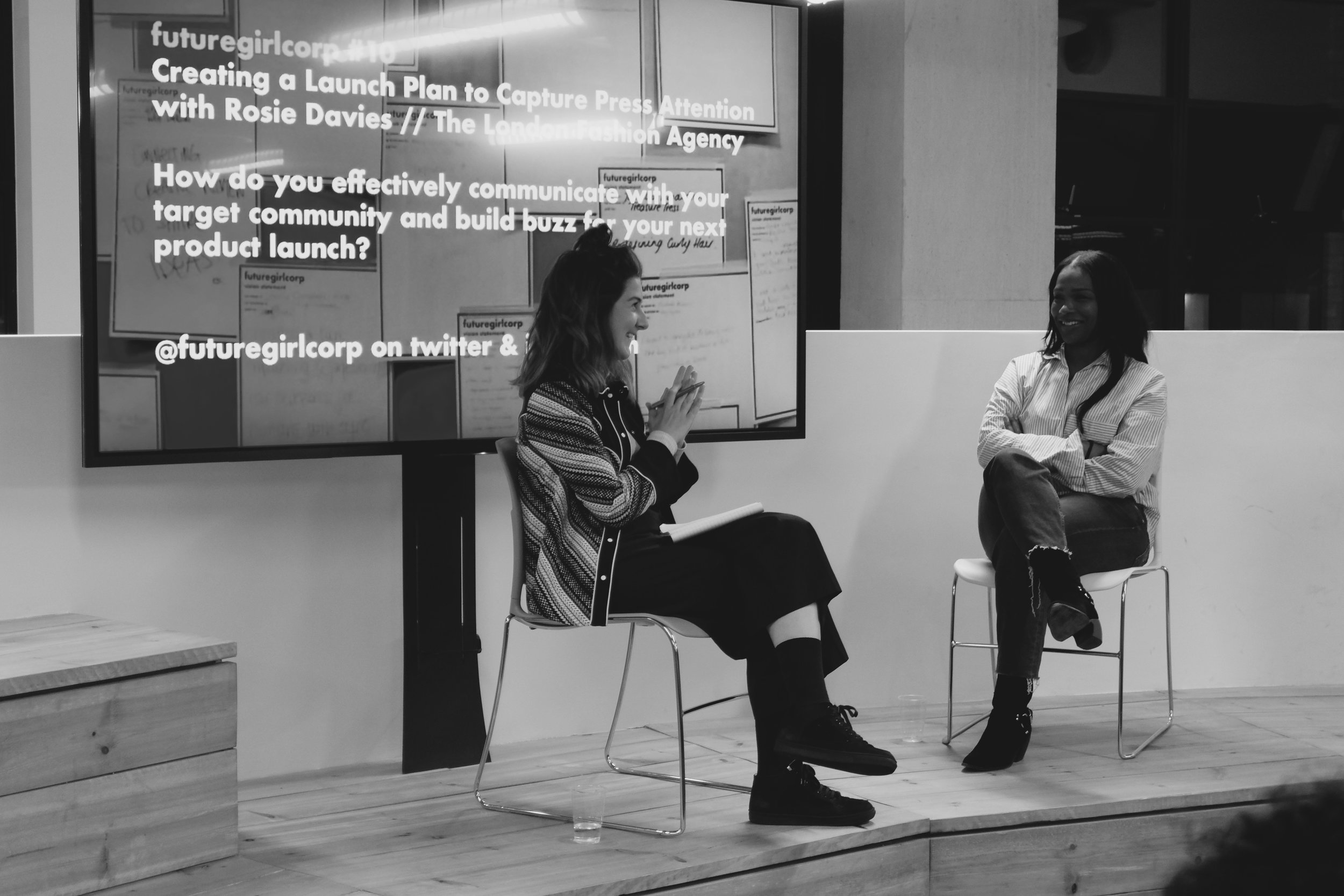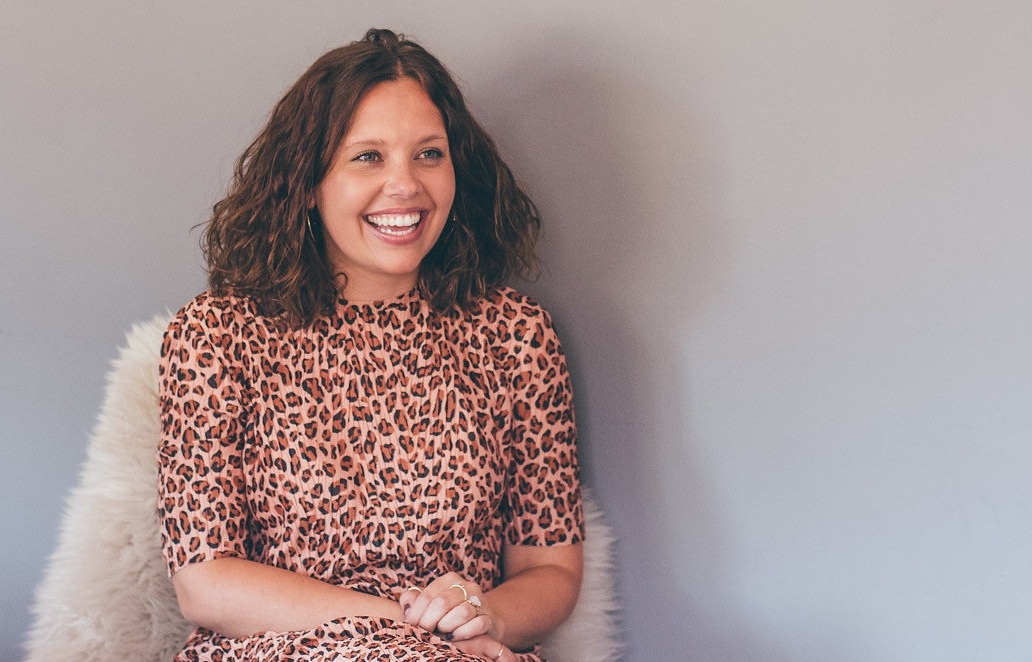FUNDS 4 FASHION

having a fashion brand isn’t just cut, sow, & sell - there is a lot to consider. with tonnes of the fgc gang working in the world of fashion, we collabed with Lone Design Club (LDC) & invited two of our members, Clio Peppiatt & Elizabeth Stiles, to share how they’re making it in fashion from a design & production perspective.
The LONDON Designer
London-based Clio Peppiatt has been growing her namesake womenswear brand since 2015 dressing the likes of Jorja Smith & Miley Cyrus
The production wiz
Elizabeth Stiles is the girl who knows buying & supplying clothes - previously doing so at @newgirlorderuk & now sharing her knowledge far and wide as a consultant.
The Headlines
We summarised the key talking points so you can manufacture your fashion seamlessly
KNOW YOUR DEMAND
When you’re creating your customer base, best to keep marketing organic so you can understand your true fans then strategise appeal.
It’s hard to keep up with who is wearing your clothes & when. It’s valuable to know so you can make the most of the visibility through your marketing. B
“One time I had 10 orders for the same bag in the same colour, for a small brand that’s a lot. Turns out a k-pop star wore my design overnight.” - Clio
Keep your clients close & build relationships so you can strategize your exposure. Elizabeth shared that, usually,
“...people need to see your item in 6 different places before they’ll remember and buy it”. - Elizabeth
Perhaps, use this as a target and work to have your clothes in front of your ideal audience (or a segment in it) 6 times in 6 months.
PRODUCTION
Sell up to what you can make. If you can’t fulfil an order, you’ll get a bad rep. Make the most of demand exceeding a supply & put a premium on your clothes until you can produce a large amount at a lower price and at a steady rate.
WANNA FLEX AT FASHION WEEK?
You totally can. “ I work with a lot of international trading grants; you get them for the likes of Paris fashion week. New York too - but make sure you have a reason to be there”.
But don’t fall into the “should” - Clio
“She got a grant for fashion week, so should I!” Do you really want to show or think you should?
HOW TO WHOLESALE
The wholesale price is the amount designers sell their clothes to retailers (i.e. Topshop), close friends & celebrities/stylists. It is lower than the RRP (recommended retail price or store price) but still provides profit per garment.
Wholesale price (usually calculated, garments cost x 2) is given to retailers so they can sell at the RRP (usually garment cost x 2.8) to make a profit on the difference .
The discount is also given to designer’s close friends & people of influence as a form of marketing as they’re getting an exclusive offer.
“It’s more marketing to get it in the right place.” - Clio
As well as getting your clothes on the “right-people”, wholesale also injects a lump of cash into your business as clothes are price-sensitive item so the discount will entice more purchases.
FASHION ANGELS
These are people who invest into fashion companies. They will ensure they get more money back than they put in so will be looking for a fashion startups that have consistent growth as this suggest lower risk of going bust and continual value that will provide an exit opportunity (an action which return are given to the investor). If you can achieve that and willing to achieve it that, great. If not - don’t!
The Q&A
Our crowd of future female fashion leaders were given the floor to ask some questions …
Q: Is it better to use seamstresses or factory/batch?
Always work with your seamstress, work with your makers. Make sure to make friends with your producers, they will be loyal to your & give you rates if you treat them well.
“..I used to always get the best [material] prices as I was nice to our manufacturers not demanding of lower prices” – Elizabeth
If you’re making around 5 garments, say with a seamstress. When you’re getting to 10 or more, then look for batches
Q: Is it viable to produce in the UK? 🇬🇧
Definitely! Producing overseas can save you money, but sometimes
“buy cheap, means buy twice” - Elizabeth
…so local production means you can physically ensure quality & communicate clearly – avoid issue made lost in translation.
Also, it’s a selling point to produce in the UK – consumers like to know it local, likely to have a smaller carbon footprint, & support local communities. Some will pay a premium for this too!
Q: How do you calculate your wholesale price?
The RRP rule of thumb is cost x 2.8, but don’t take this as bible and compare your prices to your competition. Wholesale price is usually RRP divided by 1.2. or cost x 2
Never compete on price, in the early days it’s best to build your value on service, quality, & design. If a retailer pressures your wholesale price, refer to these rules of thumbs but also think about where you can edit your garment to reduce the price. Perhaps you can
- Use a different seam
- Use a different material
- Reduce the level of details.
Just ensure the recalibration or reduction of elements doesn’t jeopardise the final outcome, ensure same desirability is achieved - sometimes it’s good to know what’s commercial then work backwards.
Q: How do I find a co-founder?
Firstly, ask, do you need one? You don’t want to give 50% of your company (or 50% of your vision!) because there is a pressure to have a joint venture. Evaluate what skills you need most then hire those in then gradually expand a team. Perhaps you just need a financial controller or business manager.
As I said don’t “should” things! - Clio
Q: How do I find investment?
Everyone has a different approach.
“a bank came to me & they found me through an old intern”. - Clio
Also, look to female-friendly banks, Sterling bank is female-founded & they have a great understanding of the potential in industry appealing to women.
There are more and more schemes, which is great! LDC has an accelerator (a programme that focuses on making your start-up happen through support, investment opportunities, and advice) you can join here: https://lonedesignclub.com/pages/ldc-accelerator
fgc have also shared insight on getting investment & what it takes to be an investor - listen here
If you’re looking to contact new investors or anyone for that matter, I find this 4 stage email process works well to ensure a reply
Pictures in an email about you (attachments are too much friction), what you do, & why’d you like to connect.
Follow up, check they got the email
Share a relevant article of information they’d be interested in.
The final, “Giving one more follow up to this as I have sent you some emails, would be good to know if this is of interest”
The final advice
Be realistic and regularly assess you in & outgoings – grow to a size & rate you can definitely achieve. Also, you can’t be ‘just’ as designer, a business head is a must too
Clio
Everyone has an idea, but not everyone executes it. Start simple and small, make a good outcome then build on it.
“Bungalow first, castle later”
Elizabeth
and that’s a wrap
Thanks to everyone who attended & big up Lone Design Club for letting us take over their space.








